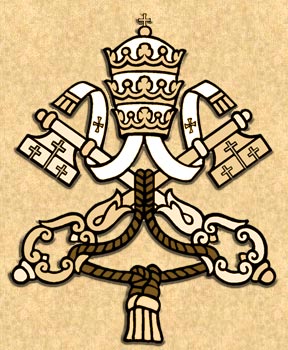
According to certain modern historians and progressive theologians, Holy Communion on the tongue became the norm in the Middle ages. Following below is their version of history.
During the Middle Ages certain distortions in the faith and/or in approaches to it gradually developed. These included an excessive fear of God and an over-concern about sin, judgment and punishment, as well as an over-emphasis on Christ's divinity-- so emphasized as to down-play His sacred humanity or virtually deny it; also an over-emphasis on the priest's role in the sacred liturgy, and a loss of the sense of the community which the Church, in fact, is. In particular, because of excessive emphasis on adoring Christ in the Holy Eucharist and an over-strict approach to moral matters, Holy Communion became more and more rare. It was considered enough to gaze upon the Sacred Host during the elevation. (In fact, in certain critics' minds the elevation, exposition and benediction of the Blessed Sacrament find their origins during the 'unfortunate' Middle Ages, a period whose liturgical practices we would do well-- so they think-- to rid ourselves of.) It was in this atmosphere and under these circumstances, they argue, that the practice of Communion in the hand began to be restricted. The practice of the priest placing the consecrated Bread directly into the mouth of the communicant thus developed and, they think, was unwisely imposed.
These progressivist theologians and historians would love to do away with the past discourage the Communion-on-the-tongue practice whereby the faithful are not allowed to "take and eat," and should return to the pristine usage of the Fathers and Apostles, namely, Communion in the hand.
It is a compelling story.Too bad that it is not true.
Here are some actual Historical examples which speak the truth.
The sacred Council of Trent declared that the custom whereby only the priest-celebrant gives Communion to himself (with his own hands), and the laity receive It from him, is an Apostolic tradition.
Pope St. Leo the Great(440-461) is an early witness of the traditional practice. In his comments on the sixth chapter of St. John's Gospel he speaks of Communion in the mouth as the current usage: "One receives in the mouth what one believes by faith." The Pope does not speak as if he were introducing a novelty, but as if this were a well established thing.
Pope St. Gregory the Great (died in 604) is another witness. In his dialogues he relates how Pope St. Agapitus performed a miracle during Mass, after having placed the Body of the Lord into someone's mouth.
In his article on "Communion" in the Dictionaire d'Archeologiae Chretienne, Leclerq declares that the peace of Constantine in 313 A.D.served toward bringing the practice of Communion in the hand to an end. After persecution had ceased, evidently the practice of Communion in the hand persisted here and there. Church authority apparently judged that it invited abuse and deemed it contrary to the custom of the Apostles.
Thus the Synod of Rouen, France, in about 878 directed: "Do not put the Eucharist in the hands of any layman or laywomen, but only in their mouths"
A non-ecumenical Council of Constantinople known as "In Trullo" in 692 A.D. prohibited the faithful from giving Communion to themselves (which is of course what happens when the Sacred Particle is placed in the hand of communicants), and decreed a censure against those who would do so in the presence of a bishop, priest or deacon.
Is it not a form of clericalism to allow the priest to touch the Sacred Host and to forbid the laity to do the same? Even priests were not allowed to touch the Blessed Sacrament except out of some need to do so.In fact, other than the celebrant of the Mass itself, no one else receiving Communion, not even a priest, could receive It in the hand. Hence in the traditional liturgical practice of the Roman Rite, if a priest were assisting at Mass (and not celebrating) and if he wished to receive Holy
Communion, he did not do so by his own hand; he received on the tongue from another priest. When Pope St. Pius X was on his deathbed in August of 1914, and Holy Communion was brought to him as Viaticum, he did not and was not allowed to receive in the hand. He received on the tongue according to the law and practice of the
Catholic Church.









No comments:
Post a Comment